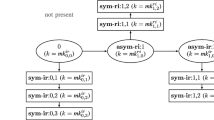Abstract
The paper discusses an experience in using Unified Modelling Language and two complementary verification tools in the framework of SAFECAST, a project on secured group communication systems design. AVISPA enabled detecting and fixing security flaws. The TURTLE toolkit enabled saving development time by eliminating design solutions with inappropriate temporal parameters.
Similar content being viewed by others
References
Armando A, Basin D, Boichut Y, Chevalier Y, Compagna L, Cuellar J, Hankes Drielsma P, Héam PC, Kouchnarenko O, Mantovani J, Mödersheim S, Von Oheimb D, Rusinowitch M, Santos Santiago J, Vigano L, Turuani M, Vigneron L (2005) The AVISPA tool for the automated validation of internet security protocols and applications. In: Proceedings of 17th international conference on computer aided verification (CAV’05). Springer-Verlag (LNCS 3576). Edinburgh, Scotland, pp. 281–285
Apvrille L, Courtiat J-P, Lohr C, de Saqui-Sannes P (2004) TURTLE: a real-time UML profile supported by a formal validation toolkit. IEEE Trans Softw Eng 30(7): 473–487
Dolev D, Yao AC (1983) On the security of public-key protocols. IEEE Trans Inform Theory 29(2): 198–208
Mota S (2008) Protocol modeling and verification for secured group communications. PhD thesis, University of Toulouse (in French)
Bouassida MS, Chrisment I, Festor O (2008) Group key management in MANETs. Int J Netw Secur IJNS 6(1): 67–79
Steiner M, Tsudik G, Waidner M (1998) CLIQUES: a new approach to group key agreement. In: Proceedings of the 18th IEEE international conference on distributed computing system, Amsterdam, pp 380–387
Meadows C (2000) Extending formal cryptographic protocol analysis techniques for group protocols and low-level cryptographic primitives. In: Proceedings of the first workshop on issues in the theory of security. Degano P, Geneva, Switzerland, pp 87–92
Taghdir M, Jackson D (2003) A lightweight formal analysis of a multicast key management scheme. In: Proceedings of 23rd IFIP international conference on formal techniques for networked and distributed systems, FORTE’03, pp 240–256
Steel G, Bundy A, Maidl M (2004) Attacking a protocol for group key agreement by refuting incorrect inductive conjectures. In: Proceedings of the international joint conference on automated reasoning. Springer-Verlag (LNAI 3097), pp 137–151
Tanaka S, Sato F (2001) A key distribution and rekeying framework with totally ordered multicast protocols. In: Proceedings of 15th IEEE international conference on information networking, ICOIN’01, pp 831–838
Steel G, Bundy A (2004) Attacking group multicast key management protocols using CORAL. In: Proceedings of the ARSPA workshop. ENTCS, vol. 125, no 1, pp 125–144
Mittra S (1997) Iolus: a framework for scalable secure multicasting. In: Proceedings of ACM, SIGCOMM’97, pp 277–288
Meadows C, Syverson P (2001) Formalizing GDOI group key management requirements in NPATRL. In: Proceedings of the 8th ACM conference on computer and communications security, pp 235– 244
Corin R, Etalle S, Hartel PH, Mader A (2004) ADER, timed analysis of Security Protocols. In: Proceedings of ACM workshop on formal methods in security engineering, Washington DC, USA, pp 26–32
Chick T, Teo JCM (2006) Energy-efficient ID-based group key agreement protocols for wireless networks. In: Proceedings of 20th parallel and distributed processing symposium
Wu B, Wu J, Fernandez B, Ilyas M, Magliveras S (2007) Secure and efficient key management in mobile ad hoc networks. J Netw Comput Appl 30(3): 937–954
Bohio M, Miri A (2004) Authenticated secure communications in mobile ad hoc networks. Proc IEEE Conf Electr Comput Eng 3: 1689–1692
Birman KP, Hayden M, Ozkazap O, Xiao Z, Bidiu M, Minsky Y (1999) Bimodal multicast. ACM Trans Comput Syst 17(2): 41–88
Birman KP, Hayden M, Hickey J, Kreitz C, van Renesse R, Rodeh O, Vogels W (2000) The Horus and Ensemble projects: accomplishments and limitations. In: Information survivability conference and exposition DISCEX ’00, vol 1, pp 149–161
Whetten B, Kaplan S, Montgomery T (1994) A high performance totally ordered multicast protocol. In: Proceedings of the workshop on theory and practice in distributed systems
Amir Y, Dolev D, Kramer S, Malki D (1992) Transis: a communication sub-system for high availability. In: Proceedings of 22nd annual international symposium on fault tolerant computing, pp 76–84
Amir Y, Moser LE, Melliar-Smith PM, Agarwal DA, Ciarfella P (1995) The totem single-ring ordering and membership protocol. ACM Trans Comput Syst 13(4): 311–342
van Renesse R, Birman KP, Maffeis S (1996) HORUS: a flexible group communication system. Commun ACM 39(4): 76–83
Gong L (1997) Enclaves: enabling secure collaboration over the internet. IEEE Trans Selected Areas Commun 15(3): 567–575
Hiltunen MA, Schlichting RD (1996) Adaptative distributed and fault-tolerant systems. Comput Syst Sci Eng 11(5): 125–133
Irrer J, Prakash A, McDaniel P (2003) Antigone: policy-based secure group communication system and AMirD: antigone-based secure file mirroring system. In: Proceedings of the DARPA information survivability conference and exposition DISCEX, pp 44–46
Almeida C (2004) Handling QoS in a dynamic real-time environment. In: Proceedings of the 8th IEEE international workshop on object-oriented real-time dependable systems, pp 217–224
Gutierrez-Nolasco S, Stehr M, Talcott C, Venkata N (2004) Exploring adaptability of secure group communication using formal prototyping techniques. In: Proceedings of 3rd workshop on adaptative and reflective middleware, Toronto, Canada
Jürjens J, Schreck J, Bartmann P (2008) Model-based security analysis for mobile communications. In: 30th international conference on software engineering (ICSE’08), Leipzig, Germany
Morimoto S, Cheng J (2005) Pattern protection profiles by UML for security specifications. In: International conference on computational intelligence for modelling control and automation (CIMCA-IAWTIC’05), Vienna, Austria
Abie H, Aredo DB, Kristoffersen T, Mazaber S, Raguin T (2005) Integrating a Security requirement Language with UML. In: 7th international conference on the unified modeling language (UML 2004), Lisbon, Portugal, LNCCS, vol 3273, pp 350–364
Woodside M et al (2009) Performance analysis of security aspects by weaving scenarios extracted from UML models. J Syst Softw 82(1): 56–74
Author information
Authors and Affiliations
Corresponding author
Rights and permissions
About this article
Cite this article
de Saqui-Sannes, P., Villemur, T., Fontan, B. et al. Formal verification of secure group communication protocols modelled in UML. Innovations Syst Softw Eng 6, 125–133 (2010). https://doi.org/10.1007/s11334-010-0122-3
Received:
Accepted:
Published:
Issue Date:
DOI: https://doi.org/10.1007/s11334-010-0122-3




